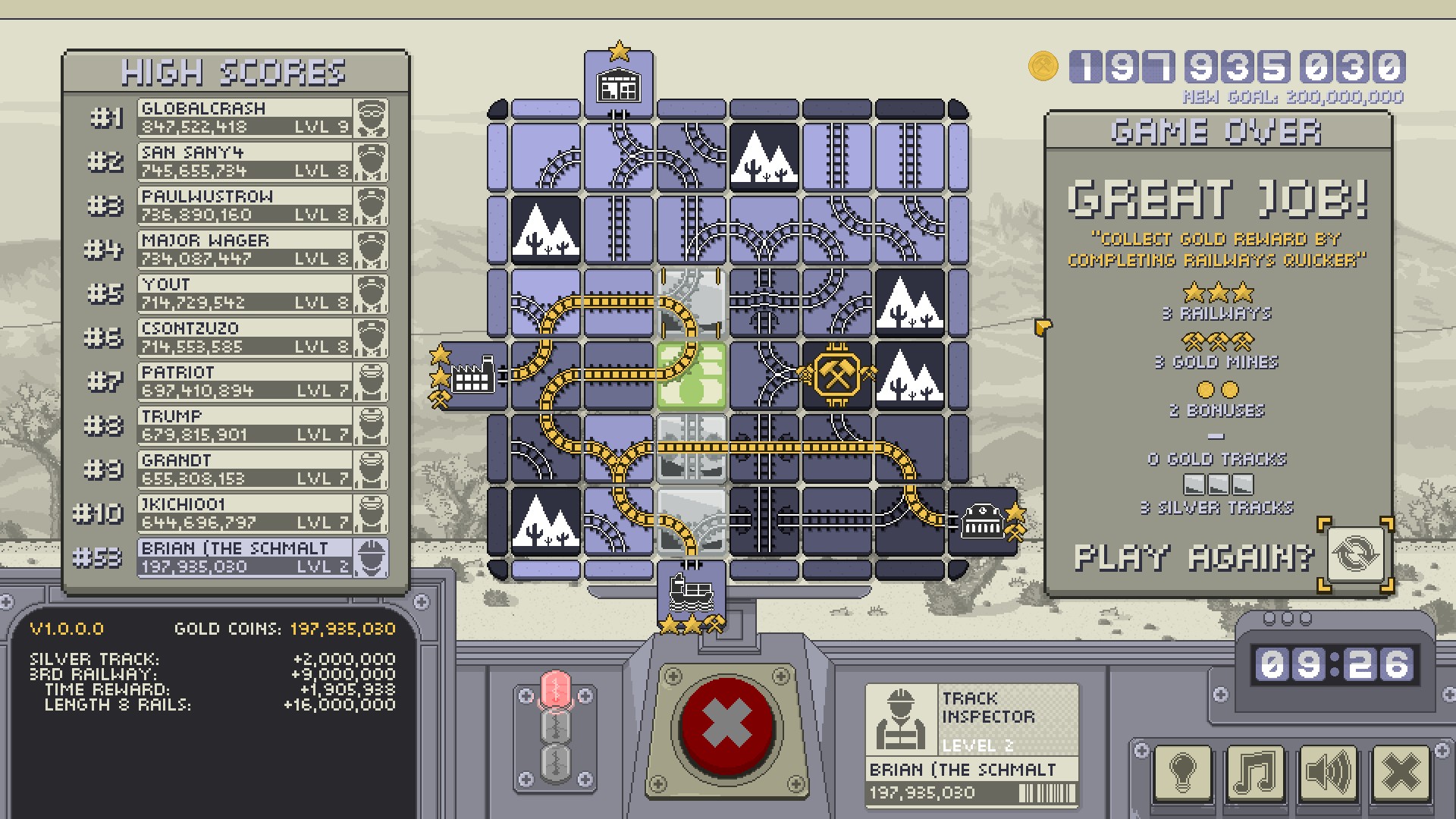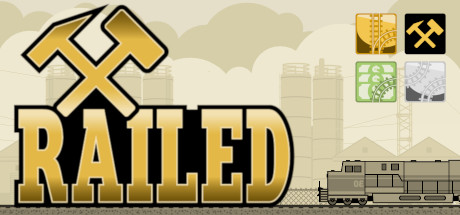When life has got you down along the tracks, take ten minutes with RAILED and you’ll feel like a contractor who gets the job done after everything when so horribly wrong in your favor.
Type: Single-player
Genre: Puzzle
Developer: WarGem LLC
Publisher: WarGem LLC
Release date: 30 August, 2019


Some part of me wanted to start with a raunchy comment about the game’s name; a second part wanted to make a Steam train pun; and another part wanted to nitpick how the board game that this game is based off of is called 30 Rails when the game uses a six-by-six grid. In any case, no one introduction communicated how or why this addictive, yet simplistic, puzzle game managed to keep me playing as much as it already has, so I’ll settle with derailing the whole idea to get to the point.
Consider Your Future Decisions on and off the Tracks
As I have previously mentioned, Railed is based on the same core rules as 30 Rails, and if you haven’t played that board game then welcome aboard. You don’t need any prior experience to figure things out on your own, although, if you went blind into the game like myself, you might be confused how this game qualifies as a “puzzle.” In fact, after one cursory search about the original game’s rules as well as watching a few Let’s Plays of the board game, you would be better off thinking of this game as an adaptation that streamlines and expands upon the pen-and-paper rules. The puzzle element comes later when you have to rethink how you approach the board in order to get the highest score, but we’re getting ahead of ourselves.
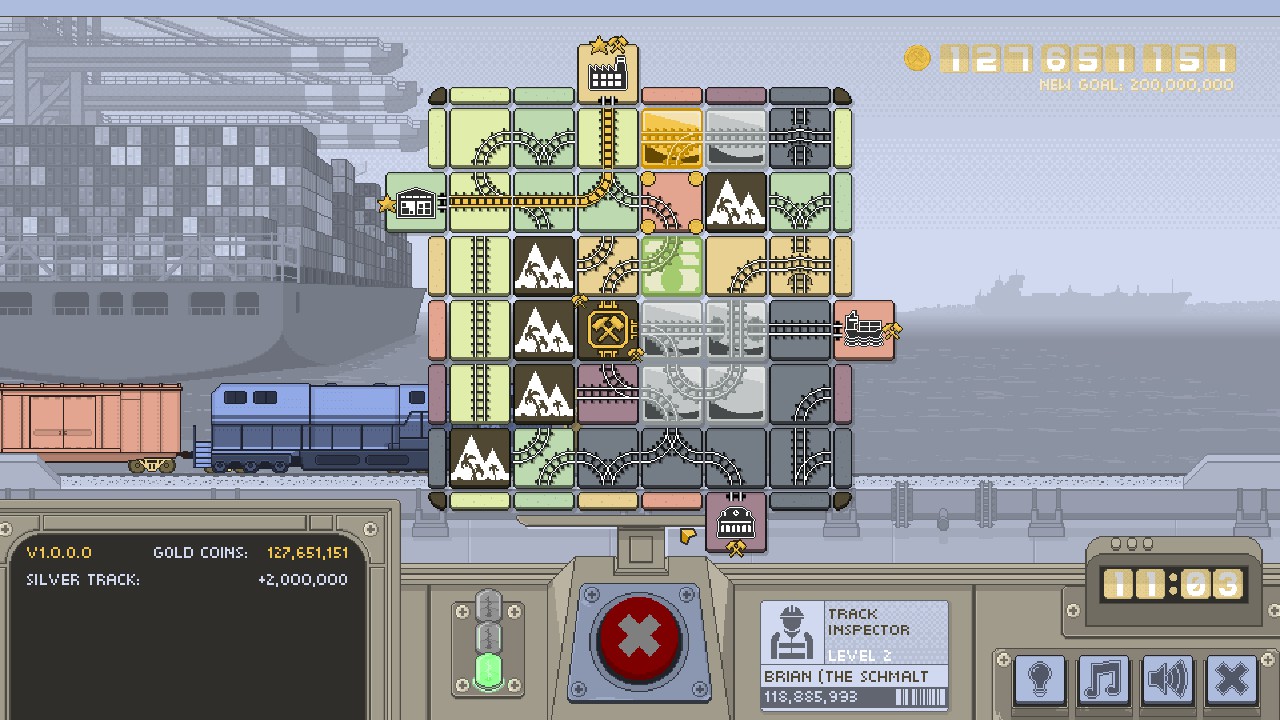
The rules and the goal of the game are fairly straight-forward. The objective is to connect as many rail-stations to one another from each corner of the board after you have chosen where to place them. Each time you mash the shiny, red button, the train in the background will slowly come to a halt; you then get a random tile-piece that you can place on the board, corresponding to the railcar’s color. Once all thirty-six tiles are filled, which is around ten to twenty minutes, the game ends.
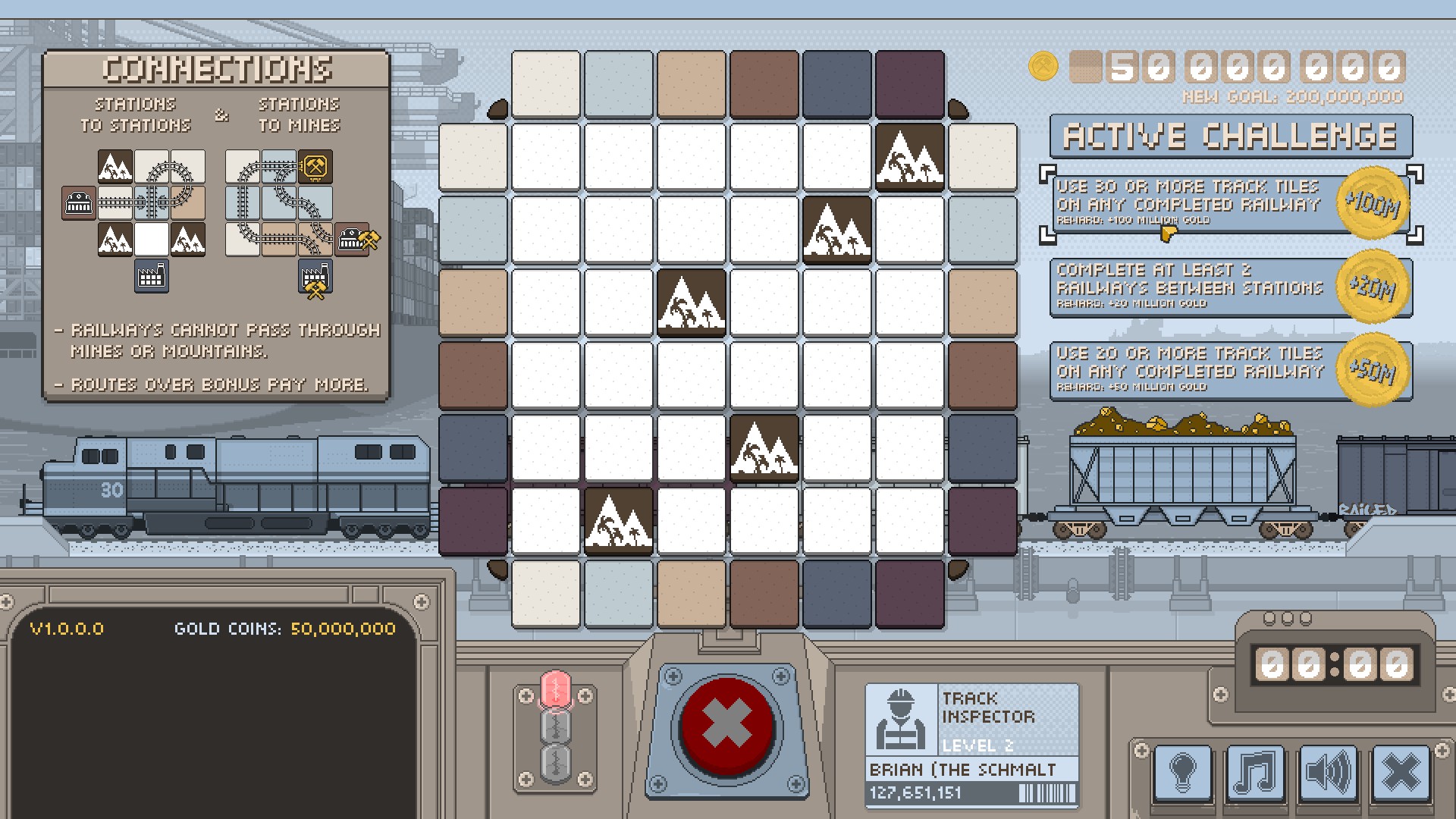
Sounds simple enough, right? However, there are more decisions to consider than what you initially might expect. For starters, while you can choose where the stations are located, there are five mountains that are randomly placed on the map (hence the name, 30 rails.) Whenever you are given a random railway-piece, you can either place it down to the corresponding color or you can choose one of the three green tiles that takes away from your starting funds (score points.) In addition to these railways, you can also set down a gold mine tile and a bonus coin tile at the start to give yourself extra points whenever you connect with them. You can also land on special railcars that give you extra funds if you use these silver (displayed) or gold (randomized) tiles. Finally, the objective for those who want to obtain the highest scores will have to make clever usage of the rails themselves, and it’s here where the game becomes far more complex than simply slotting Rail A into Station B.
Beyond the Quantifiable, Numbers with Purpose and Nonnumerical Values
Scoring systems by themselves are often intrinsic rewards with little extrinsic value; they may incorporate progression systems, achievements, leaderboards, unlockable rewards and rules far more subtle to achieve a greater sense of success. Many games choose from these extrinsic rewards, but it’s the last category that truly utilizes the scoring system in a manner to enhance the core gameplay. You can easily look at the original Pac-Man to its Championship counterparts to identify the differences in how they value their scoring systems as well as how those systems apply to the gameplay. Railed is game somewhere in the middle of these two extremes, but its extrinsic rewards help drive players without informing the player how to achieve them—and that challenge is the game’s greatest puzzle.
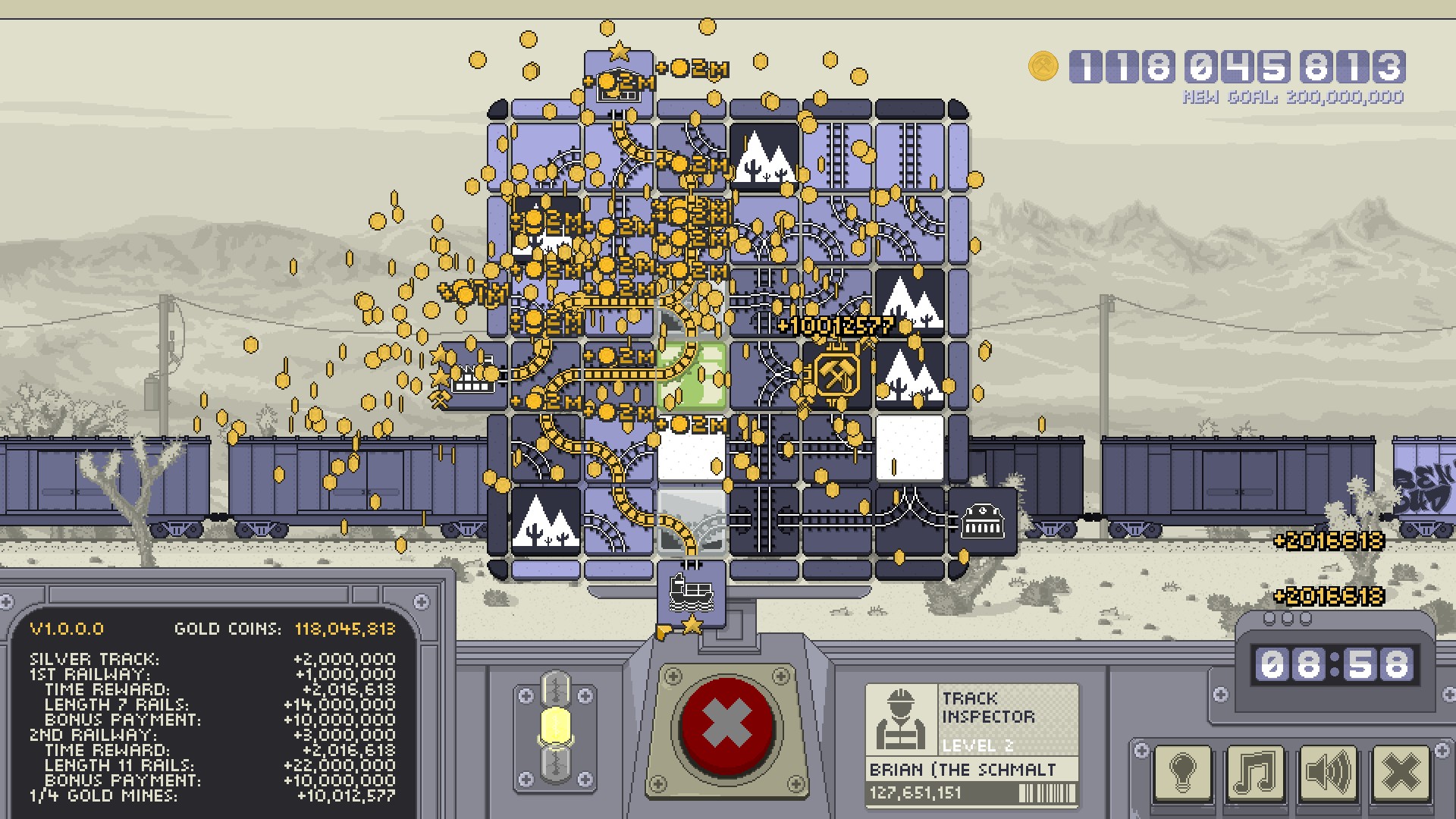
Now, that introduction may have sounded more confusing than I intended, so it would be easier to showcase this point in practice. In Railed, there are five main factors to consider in determining the player’s score: Luck, time, railways, conjunctions and active challenges. Almost all these elements can be equally influenced by the player as well as by the game, but it’s that careful balance that keeps the scoring system from having a perfect solution.
To describe this outcome another way, if you could simply choose the map layout, the placement of all objects, and the order you receive those pieces, then the game itself would simply be a six-by-six mathematical problem with one defined solution. Although you can attribute luck to all of these categories, it’s important to consider that aspect separately because it keeps the scoring system from having a max value. You cannot predict what the layout would like; you cannot know how long it will take you to think quickly; and you cannot predetermine the rails you will receive, the placement of those rails nor the active challenges available to you. When viewed in this manner, you might consider Railed to be entirely reliant on luck without any skills to accumulate as you play, but we haven’t factored in how those extrinsic motivations play a vital role.
In most games, achievements are simply extraneous motivations that help players find or obtain everything a game has to offer, but in Railed they are the game’s teacher on how to improve. From the outset, connecting four railways might seem daunting enough; however, you quickly learn with enough practice how to get better at setting up multiple routes that those “twenty/thirty rail” challenges will feel like the real task. Everything from the active challenges to the achievements encourages players to strive to do better than they did last time, and the extra challenges are little nudges for the player how to get there, or at least encourage you to try again. Once you have mastered how to do the task once, doing it again becomes less guesswork for yourself, and you’ll have catalogued your own strategies to achieve that same goal more consistently with less time. With how short these individual sessions can be and how much the game automates the less important aspects, the time-commitment to show improvement isn’t something that will detract most players, even if they lack their own motivation.
”Last Boarding Stop for Future Score-Junkies! All Aboard!”
You might wonder with all the quality-of-life improvements added to 30 Rails whether or not this game has replaced the board game itself, and my answer to the question is no. Besides the simple fact that some people prefer the board game experience over a video-game experience, the board game allows you to play the game with others. (You could simply use screenshare to play the game among your friends either as a hot-seat experience or a competition with each other’s game, but let’s keep thing simple for the sake of argument.) The only reason I could see why others wouldn’t enjoy this type of game is if they haven’t yet found their inner score-junkie or if the game itself is too luck-based for their tastes, and those concerns are fair enough. At five dollars, however, is there really anything left to lose?
